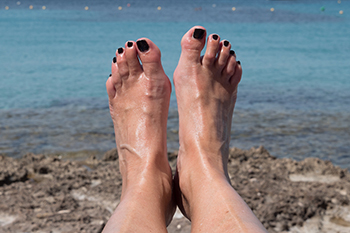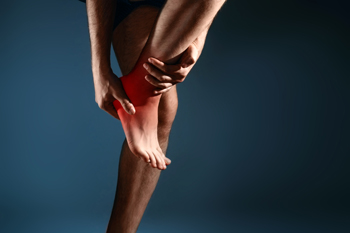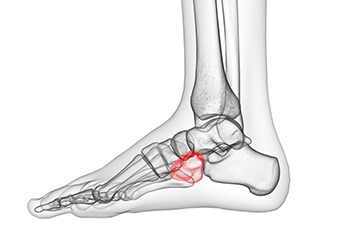Connect With Us
Blog
Items filtered by date: August 2022
The Dangers of Wearing Flip Flops

People enjoy wearing flip flops, especially during the summer. They can be stylish, are easy to put on and take off, they expose feet to the air, and keep feet free from athlete’s foot. But flip flops also have negative health effects. Flip flops are loose and do not have proper support. They can cause your feet to hurt if you wear them too much or too long. If you trip or fall, your feet are more likely to get injured when wearing flip flops. Exposure of the skin when wearing flip flops leaves one prone to skin injuries and sunburn or frostbite. The lack of support can affect other body parts, such as the back, hips or leg muscles. Wear flip flops casually and in moderation. See a podiatrist if you find that you are developing pain in your feet from footwear, such as flip flops, or for any other reason. This type of doctor can help diagnose problems with feet and ankles and provide necessary treatment.
Flip-flops are not always the best choice of footwear. If you have any concerns about your feet or ankles, contact Philip K. Schrumpf, DPM from Active Feet Clinic. Our doctor will assist you with all of your foot and ankle needs.
Flip-Flops and Feet
When the weather starts warming up, people enjoy wearing flip-flops. Flip-flops are comfortable, stylish, and easy to slip on and off; they're perfect for any summer beach goer. However, these shoes can cause harm to the feet.
How Can Flip-Flops Affect Me Long-Term?
- Ankle problems
- Hip problems
- Lower back problems
- Pain in the balls of the feet
- Problems with foot arches
- Changes in the way you walk
Are There Injuries Associated with Flip-Flops?
Yes. Since flip-flops are relatively weak and do not provide the same amount of support as sneakers, people who wear flip-flops regularly are more susceptible to injuries. On top of that, the open nature of the shoe makes your feet more prone to other problems, such as cuts and even infections. Common injuries and ailments include:
- Sprained ankles
- Blisters
- Infections
- Cuts and Scrapes
I like Wearing Flip-Flops. Are There Safe Alternatives?
When buying flip-flops, try to find ones that have sturdy soles and that are made of high-quality materials that will support for your feet. These flip-flops will cost more but will also last longer as a result.
If you have any questions please feel free to contact our office located in Missoula, MT . We offer the newest diagnostic and treatment technologies for all your foot and ankle needs.
What is Freiberg’s Disease?

Despite the fact that Freiberg’s disease is a rare foot condition, it can still be helpful to learn more about the affliction in case you or a loved one develops it. Generally speaking, an individual who suffers from Freiberg’s disease has a fractured base of the metatarsal bones, located on the ball of the feet. This primarily affects the second and third metatarsal bones. There are multiple potential causes of Freiberg’s disease. First, the disease can be caused by excessive weight-bearing activities—such as jumping and running—that put extra strain on the ball of the feet. This can essentially lead to sustained trauma over time, ultimately resulting in Freiberg’s disease. If you have Freiberg's disease, you might notice a sense of pain and discomfort around the affected area. It is also common for someone who suffers from this condition to experience swelling and bruising of some sort on and around the feet. Rare foot conditions certainly will not affect everyone. However, it is possible that you or someone you know could be affected. If you think that you could have Freiberg’s disease, reach out to a podiatrist who will be able to help you.
Some foot conditions may require additional professional care. If you have any concerns, contact Philip K. Schrumpf, DPM of Active Feet Clinic. Our doctor can provide the care you need to keep you pain-free and on your feet.
Rare Foot Conditions
The majority of foot conditions are common and can be treated by a podiatrist. Standard diagnostic procedures are generally used to identify specific conditions and treatment can be rendered. A podiatrist also treats rare foot conditions which can be difficult to diagnose and may need extra attention and care.
There are many rare foot conditions that can affect children. Some of these can include:
- Freiberg’s disease
- Kohler’s disease
- Maffucci syndrome
Freiberg’s disease - This can be seen as a deterioration and flattening of a metatarsal bone that exists in the ball of the foot. It typically affects pre-teen and teenage girls, but can affect anyone at any age. Symptoms that can accompany this can be swelling, stiffness, and the patient may limp.
Kohler’s disease - This often targets the bone in the arch of the foot and affects younger boys. It can lead to an interruption of the blood supply which ultimately can lead to bone deterioration. The patient may limp or experience tenderness, swelling, and redness.
Maffucci syndrome - This affects the long bones in a child’s foot leading to the development of abnormal bone lesions. They are benign growths and typically develop in early childhood and the bones may be susceptible to breaking.
A podiatrist can properly diagnose and treat all types of rare foot conditions. If your child is affected by any of these symptoms or conditions, please don’t hesitate to call our office so the correct treatment method can begin.
If you have any questions please feel free to contact our office located in Missoula, MT . We offer the newest diagnostic tools and technology to treat your foot and ankle needs.
Plantar Fasciitis Is a Common Type of Heel Pain

Because heel pain can be caused by several conditions, it is important to have it diagnosed correctly and treated properly. The most common form of heel pain is plantar fasciitis. This is an inflammatory condition of the plantar fascia, which is the long rubber band-like connective tissue that connects the front of the heel bone with the toes. The plantar fascia is on the bottom of the foot. It undergoes a great deal of stress and pressure while doing its duty of helping to form the arch, aiding in the propulsive phase of the walking cycle, and acting like a shock absorber of sorts. Excessive wear and tear and stretching of the plantar fasciitis can irritate it, inflame it, and even create micro-tears where it inserts at the heel bone. This is known as plantar fasciitis, a very painful form of heel pain. Plantar fasciitis can be brought on by certain sporting activities like running, being obese, standing for prolonged periods, and more. If you have heel pain that is at its worst in the morning when you take your first steps of the day, or after periods of rest, you may have plantar fasciitis. Consult with a podiatrist to have your heel pain diagnosed and treated.
Plantar fasciitis can be very painful and inconvenient. If you are experiencing heel pain or symptoms of plantar fasciitis, contact Philip K. Schrumpf, DPM from Active Feet Clinic. Our doctor can provide the care you need to keep you pain-free and on your feet.
What Is Plantar Fasciitis?
Plantar fasciitis is the inflammation of the thick band of tissue that runs along the bottom of your foot, known as the plantar fascia, and causes mild to severe heel pain.
What Causes Plantar Fasciitis?
- Excessive running
- Non-supportive shoes
- Overpronation
- Repeated stretching and tearing of the plantar fascia
How Can It Be Treated?
- Conservative measures – anti-inflammatories, ice packs, stretching exercises, physical therapy, orthotic devices
- Shockwave therapy – sound waves are sent to the affected area to facilitate healing and are usually used for chronic cases of plantar fasciitis
- Surgery – usually only used as a last resort when all else fails. The plantar fascia can be surgically detached from the heel
While very treatable, plantar fasciitis is definitely not something that should be ignored. Especially in severe cases, speaking to your doctor right away is highly recommended to avoid complications and severe heel pain. Your podiatrist can work with you to provide the appropriate treatment options tailored to your condition.
If you have any questions please feel free to contact our office located in Missoula, MT . We offer the newest diagnostic and treatment technologies for all your foot and ankle needs.
Many People Experience Foot Pain

Many people experience foot pain at some point in their lives. Research has indicated that approximately 75,000 miles have been walked by the age of 50, and the likelihood is high that foot pain can develop. A common foot condition is athlete’s foot, and this is contagious. It is caused by a fungus that lives and thrives in warm and moist environments including shower room floors, public swimming pools, and locker rooms. Blisters can be quite uncomfortable and may develop from wearing shoes that do not fit correctly. A bunion is defined as a bony lump on the side of the big toe and is considered to be a deformity. Bunions can occur as a result of genetic factors or from wearing shoes that do not have adequate room for the toes to move freely. If the bunion is severe, surgery may be required for permanent removal. Another popular ailment is heel pain, which is most frequently caused by plantar fasciitis. Children can also develop heel pain known as Sever’s disease. Gout is said to be more prevalent among men and typically results from having excess uric acid in the blood. This causes crystals to form in the joints of the big toe and can cause debilitating pain. If you have any foot pain, it is strongly advised that you are under the care of a podiatrist who can properly diagnose and treat your condition.
Foot Pain
Foot pain can be extremely painful and debilitating. If you have a foot pain, consult with Philip K. Schrumpf, DPM from Active Feet Clinic. Our doctor will assess your condition and provide you with quality foot and ankle treatment.
Causes
Foot pain is a very broad condition that could be caused by one or more ailments. The most common include:
- Bunions
- Hammertoes
- Plantar Fasciitis
- Bone Spurs
- Corns
- Tarsal Tunnel Syndrome
- Ingrown Toenails
- Arthritis (such as Gout, Rheumatoid, and Osteoarthritis)
- Flat Feet
- Injury (from stress fractures, broken toe, foot, ankle, Achilles tendon ruptures, and sprains)
- And more
Diagnosis
To figure out the cause of foot pain, podiatrists utilize several different methods. This can range from simple visual inspections and sensation tests to X-rays and MRI scans. Prior medical history, family medical history, and any recent physical traumatic events will all be taken into consideration for a proper diagnosis.
Treatment
Treatment depends upon the cause of the foot pain. Whether it is resting, staying off the foot, or having surgery; podiatrists have a number of treatment options available for foot pain.
If you have any questions, please feel free to contact our office located in Missoula, MT . We offer the newest diagnostic and treatment technologies for all your foot care needs.
Wounds That Don't Heal Need to Be Checked
What Is Cuboid Syndrome?

In cuboid syndrome, the small, square-shaped cuboid bone on the outside of the midfoot becomes partially dislocated. Cuboid syndrome can cause foot pain in this area, along with weakness in the foot. This condition may occur when the ankle has been sprained or twisted, through overuse/repetitive strain, or by having flat feet. Along with pain and/or foot weakness, there may be redness, swelling, or bruising on the outside of the midfoot. If you suspect that you have cuboid syndrome, contact a podiatrist. They will examine to see exactly where the pain is emanating from. If they determine that you have cuboid syndrome, they may try to treat it with rest, ice therapy, orthotics, and taping. They may even determine that manipulating the bone back into alignment is possible with procedures known as the cuboid whip or the cuboid squeeze. Manipulation is more successful if it is performed shortly after the injury has occurred, so it is important to seek treatment from a podiatrist as soon as possible.
Cuboid syndrome, also known as cuboid subluxation, occurs when the joints and ligaments near the cuboid bone in the foot become torn. If you have cuboid syndrome, consult with Philip K. Schrumpf, DPM from Active Feet Clinic. Our doctor will assess your condition and provide you with quality foot and ankle treatment.
Cuboid syndrome is a common cause of lateral foot pain, which is pain on the outside of the foot. The condition may happen suddenly due to an ankle sprain, or it may develop slowly overtime from repetitive tension through the bone and surrounding structures.
Causes
The most common causes of cuboid syndrome include:
- Injury – The most common cause of this ailment is an ankle sprain.
- Repetitive Strain – Tension placed through the peroneus longus muscle from repetitive activities such as jumping and running may cause excessive traction on the bone causing it to sublux.
- Altered Foot Biomechanics – Most people suffering from cuboid subluxation have flat feet.
Symptoms
A common symptom of cuboid syndrome is pain along the outside of the foot which can be felt in the ankle and toes. This pain may create walking difficulties and may cause those with the condition to walk with a limp.
Diagnosis
Diagnosis of cuboid syndrome is often difficult, and it is often misdiagnosed. X-rays, MRIs and CT scans often fail to properly show the cuboid subluxation. Although there isn’t a specific test used to diagnose cuboid syndrome, your podiatrist will usually check if pain is felt while pressing firmly on the cuboid bone of your foot.
Treatment
Just as the range of causes varies widely, so do treatments. Some more common treatments are ice therapy, rest, exercise, taping, and orthotics.
If you have any questions, please feel free to contact our office located in Missoula, MT . We offer the newest diagnostic and treatment technologies for all your foot care needs.
Blog Archives
- August 2024
- July 2024
- June 2024
- May 2024
- April 2024
- March 2024
- February 2024
- January 2024
- December 2023
- November 2023
- October 2023
- September 2023
- August 2023
- July 2023
- June 2023
- May 2023
- April 2023
- March 2023
- February 2023
- January 2023
- December 2022
- November 2022
- October 2022
- September 2022
- August 2022
- July 2022
- June 2022
- May 2022
- April 2022
- March 2022
- February 2022
- January 2022
- December 2021
- November 2021
- October 2021
- September 2021
- August 2021
- July 2021
- June 2021
- May 2021
- April 2021
- March 2021
- February 2021
- January 2021
- December 2020
- November 2020
- October 2020
- September 2020
- August 2020
- July 2020
- June 2020
- May 2020
- April 2020
- March 2020
- February 2020
- January 2020
- December 2019
- November 2019
- October 2019
- September 2019
- August 2019
- July 2019
- June 2019
- May 2019
- April 2019
- March 2019

